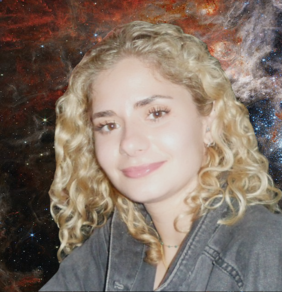The Ernst Patzer Foundation is awarding up to three prizes each year for the best refereed publications by doctoral students and young postdocs at MPIA and ZAH. In 2024, Patzer Award for Brooke Polak (ITA) and Jose Eduardo Mendez-Delgado (ARI) are among the awardees.
Dr. Brooke Polak receives this prize for her paper on Massive star cluster formation II. Runaway stars as fossils of subcluster mergers, 2024, Astronomy & Astrophysics 690, A207
Together with Dr. Ralf Klessen and Dr. Simon Glover, Brooke Polak identified a new mechanism for the ejection of runaway stars from young clusters: the subcluster ejection scenario (SCES). Star clusters form hierarchically, with subclusters of stars forming from over densities in the turbulent gas and dynamically merging into a central cluster. She performed simulations of massive star clusters forming from their natal gas clouds following the formation of individual stars and their feedback. In these simulations, it was found that a late forming subcluster gets tidally disrupted as it merges, creating a tidal tail of runaway stars with the same ejection direction. Runaways formed via SCES are highly correlated in ejection angle, age, and speed, providing a metric to identify them in observations. Promising SCES runaway candidates have been identified leaving the R136 cluster in 30 Doradus. Runaway stars of this type can be used to probe the assembly history of their parent star cluster.
Dr. Jose Eduardo Mendez-Delgado was honored with the Patzer Prize for his research paper on Gas-phase Fe/O and Fe/N abundances in Star-Forming Regions: Relations between nucleosynthesis, metallicity and dust, 2024, Astronomy & Astrophysics
In collaboration with Dr. Kathryn Kreckel and Dr. Andreas Sander form ZAH/ARI, he analyzed the gas-phase Fe abundances in hundreds of star-forming nebular regions across multiple galaxies, exploring its relationship with the abundance of other heavy elements, nucleosynthesis, and the creation and destruction of interstellar dust. Fe is a heavy element primarily produced in Type Ia supernovae and is the most studied element in stellar objects. Its relative abundance compared to alpha elements, such as O, is directly related to the star formation history of galaxies, which helps us understand their origin and evolution. However, measuring Fe abundance in ionized nebulae is challenging, as it is often locked within dust grains. Eduardo and his collaborators found that the fraction of Fe trapped in dust grains can be estimated from the abundance of other elements, such as N, allowing the total Fe abundance to be determined even in more distant galactic systems, including galaxies observed with the James Webb Space Telescope.
The award winners will be honored during the Patzer Colloquium on November 29th, 2024, at 15:00 in the MPIA Lecture Hall.
BACKGROUND INFORMATION
The Scientific Ernst Patzer Foundation was established in 2001 by the widow of the Philosopher Ernst Patzer. The goal of the foundation is to support young scientists in the field of astronomy, in particular at the Max Planck Institute for Astronomy in Heidelberg and ZAH. For more information see http://www.mpia.de/studfy-and-career/ernst-patzer-award.
LOCAL CONTACTS
Dr. Brooke Polak
Center for Astronomy of Heidelberg University (ZAH)
Institut für Theoretische Astrophysik
Brooke.Polak@uni-heidelberg.de
Dr. Mohammadreza Ayromlou
Center for Astronomy of Heidelberg University (ZAH)
Astronomisches Rechen-Institut (ARI)
oh295@uni-heidelberg.de


